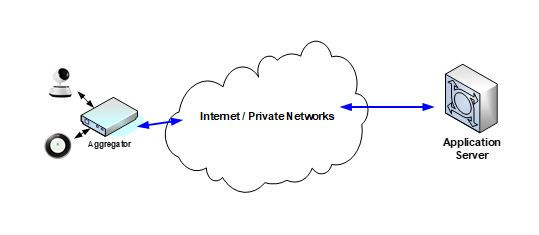Blockchain is far more widely useful than for just crypto- currencies such as Bitcoin. Blockchains create immutable, persistent, and searchable records of events, transactions, contracts, and official documents.

If we think beyond the realm of humans interacting with each other and look forward to the new world of autonomous systems interacting with each other, blockchain technology gives us a simple, cost-effective, and permanent record of decisions made and communicated on our behalf. [1]
An example of a IoT network is exemplified by the figure above, which illustrates how Internet of Things nodes can be managed by a server or a set of servers. This diagram explains the possible topology of an IoT network.
Referring to the figure, part of the management software resides in the Aggregator and another part resides in the Application Server(s), with both parts written in an executable programming language like C. The purpose of these software blocks in the aggregator and the server would be, for example, to ensure that the interaction between the aggregator and the server is secure and meets established performance requirements. The private network referred to in the figure could be based on several technologies like Private Enterprise Networks based on Carrier Ethernet, Virtual Private Network (VPN) or a private Blockchain network.
Depending on the through-put requirements needed, the private network could be a combination of a Virtual Private Network (VPN) and a Blockchain network where the data from/to the sensors to/from the server travel through the VPN but the management information which needs to be very secure is passed from the server to the aggregators or vice-versa using the Blockchain network.
Machine Learning (ML) and Artificial Intelligence (AI) allow machines to reason and learn in ways once associated only with humans. Combine ML/AI with IoT, and you have something vastly more interesting than either one by itself - the ability to recognize meaningful patterns buried in mountains of data, and do so in fractions of a second, in ways that would be exceptionally more difficult for most humans. Better yet, the algorithms get smarter over time. [1]
To develop and enable applications such as mission-critical and secure IoT networks, one needs a platform that can be used to develop the software residing in the network’s sensors, actuators, aggregators, and servers. Additionally, simulation capability is needed to ensure that a network consisting of a large number of aggregators and servers ultimately operates with the performance and security needed for its intended application.
DomaniSystems’ Decentralized Collaboration and Integration Platform’s (DCP) design objective is to address these requirements.
Comments